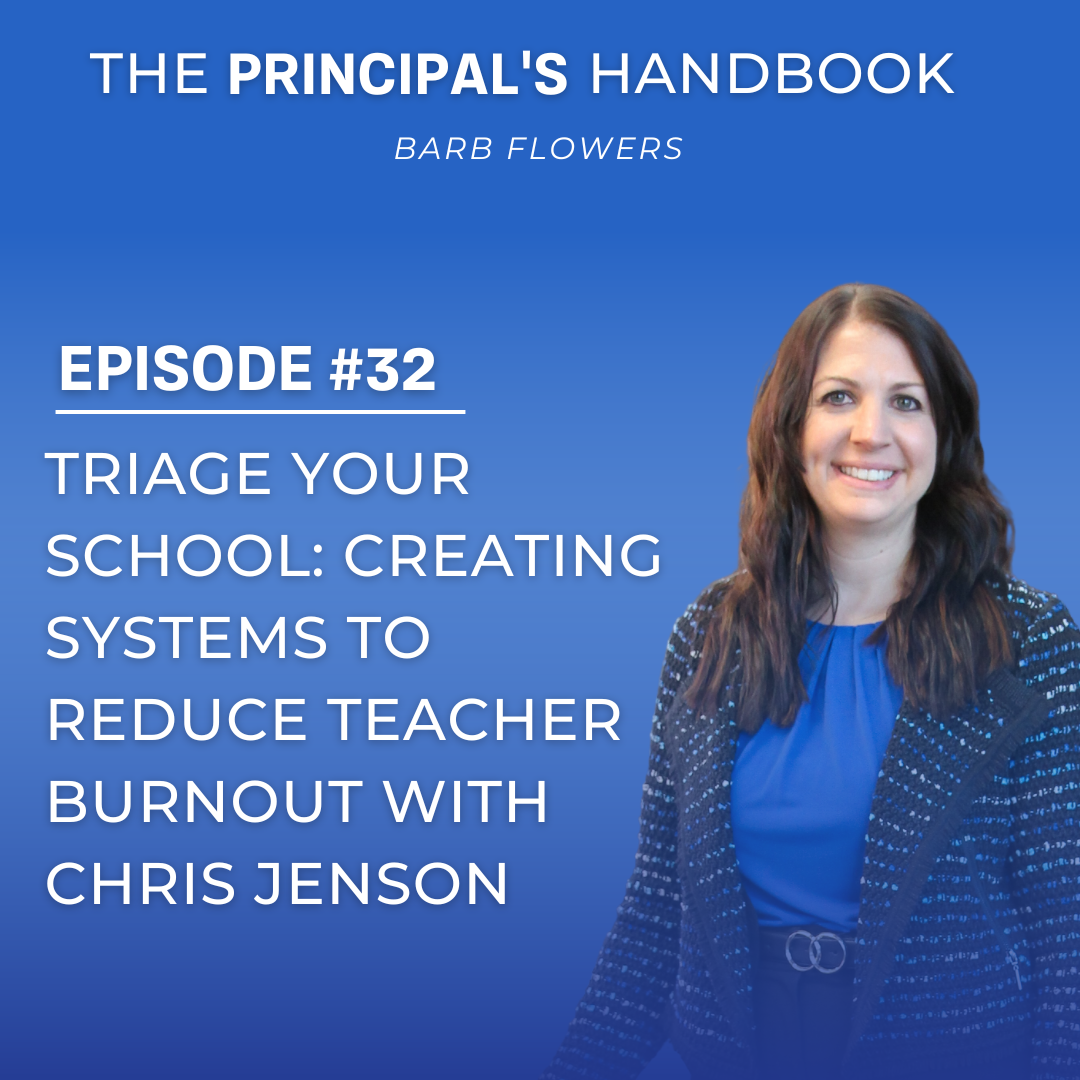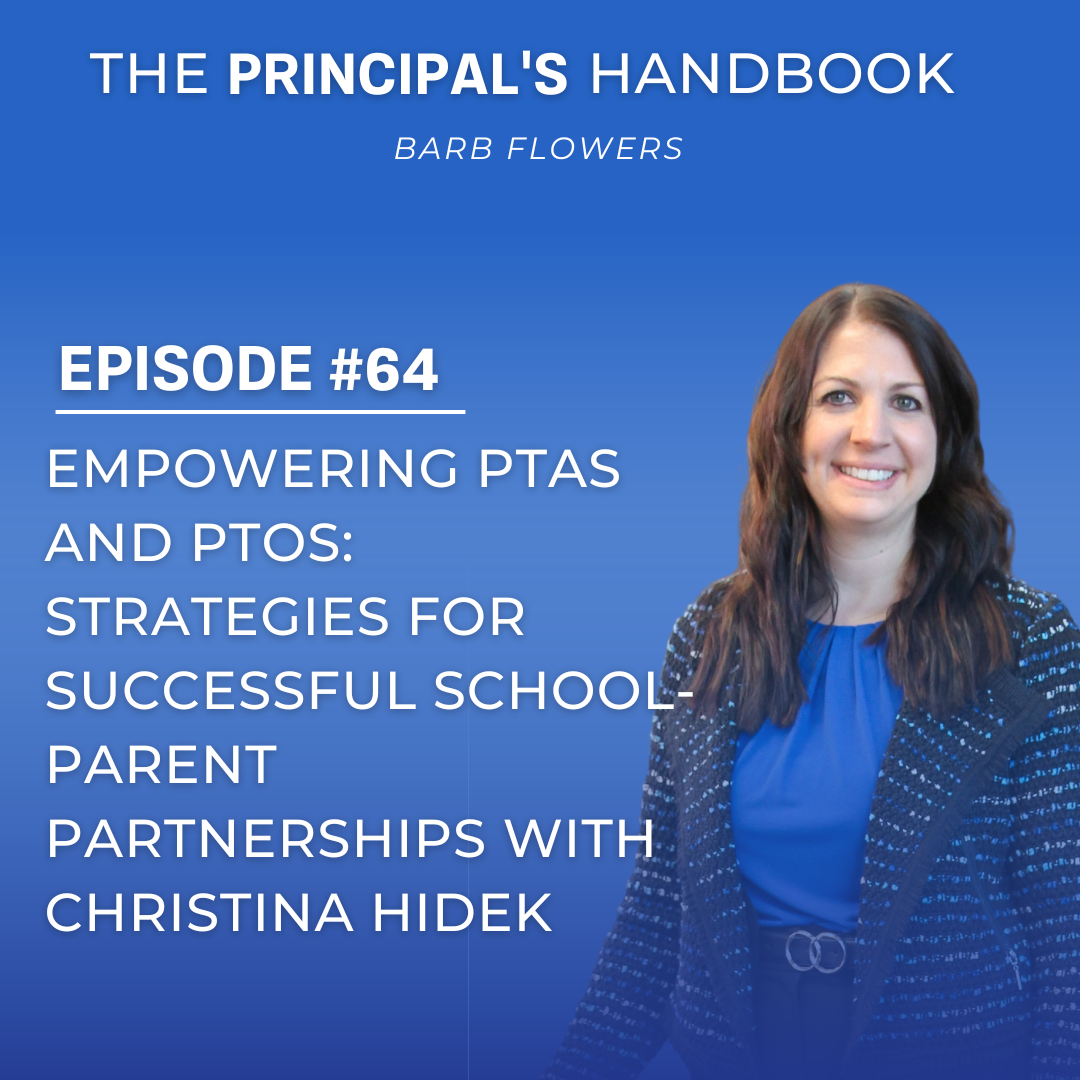[00:00:00]
In today’s episode, I’m chatting with Chris Jensen, a former physician and high school teacher. We’ll be discussing his newest book, Triage Your School: A Physician’s Guide to Preventing Teacher Burnout. We’re going to dive into how you can prevent teacher burnout and create systems in your school to address it for good. Stay tuned!
[00:01:00]
Welcome to The Principal’s Handbook, your go-to resource for principals looking to revamp their leadership approach and prioritize self-care. I’m Barb Flowers, a certified life coach with eight years of experience as an elementary principal. Tune in each week as we explore strategies for boosting mental resilience, managing time effectively, and nurturing overall wellness. From tackling daily challenges to maintaining a healthy work-life balance, I’m here to help you navigate the complexities of school leadership. Welcome to a podcast where your well-being is the top priority.
[00:02:00]
I’m excited to have Chris Jensen with us today. He’s the author of Triage Your School: A Physician’s Guide to Preventing Teacher Burnout, and he’s here to talk about teacher burnout and share practical strategies from his book. Chris, welcome! Could you start by introducing yourself and telling us about your background and how you decided to write this book?
Chris Jensen:
Thank you so much for having me! It’s truly a privilege to be here. My background has been quite a journey, starting as an ER physician for more than a decade. I became very familiar with the concept of burnout, which led me to make a career change. Eventually, I transitioned from the emergency room to the classroom as a high school teacher. It’s often joked that both fields are equally traumatic and demanding! But seriously, after teaching for 10 years and leveraging my medical experience, I became increasingly interested in the health-related issues in schools—everything from supporting diabetic students to managing asthma protocols, mental health, and, of course, staff stress and burnout.
As I began working more closely with staff on burnout prevention, I realized I had a lot of valuable strategies to share. After receiving multiple requests to provide support on this issue, it dawned on me that I should write a book. Solution Tree was the perfect fit to help me take these ideas and turn them into something readable and impactful for educators.
[00:04:00]
Barb:
That’s an incredible journey! So, how did you make the leap from being an ER physician to becoming a teacher? What inspired that shift?
Chris Jensen:
Well, in all honesty, the financial improvement wasn’t the main motivator! [laughs] But in my time as an ER physician, one of my favorite parts of the job was teaching. I loved working with medical students and junior residents, teaching them at the bedside, sharing what I had learned, and passing along those little tricks. When I was deciding to leave medicine, I realized that teaching was the aspect of my job I loved most. So, I decided to make the leap to teaching high school, and while I was prepared for a challenge, I quickly realized that managing a classroom of students was a lot more difficult than I anticipated. It was a tough adjustment, but one I grew to love.
[00:05:00]
Barb:
That’s so interesting! I imagine the students must have been fascinated by your background in medicine. How did they respond to your unique career change?
Chris Jensen:
It was definitely a fun experience. Some students were really curious and even asked if I had ever made any mistakes as a doctor. Others expressed an interest in healthcare careers and asked for advice about pursuing careers in nursing or medicine. It was a great opportunity to bring real-world examples into the classroom and connect science concepts to practical applications, especially drawing from my time in the ER.
[00:06:00]
Barb:
That’s such a neat way to connect with students. Let’s dive into the book. One concept I really appreciate is your exploration of why self-care alone isn’t enough to prevent burnout. Can you expand on that for us?
Chris Jensen:
Absolutely. First off, I’m all for self-care. I use it in my own life, whether it’s going for a run or playing guitar to unwind. Self-care does have value. However, my concern is that many schools have focused so heavily on self-care as a solution to burnout that it’s almost become a quick fix. The problem is that self-care doesn’t address the root causes of burnout—the overwhelming workload, the expanding duties, and the constant barrage of responsibilities that teachers face.
Self-care can be a pause in your day, offering brief relief and joy, but it doesn’t resolve the systemic issues that are causing burnout. If you’re teaching large classes and juggling multiple responsibilities, no amount of self-care will change the reality of your day-to-day struggles. While self-care isn’t bad, it hasn’t been the magic solution to burnout. So, we need to look at other ways to address these challenges.
[00:07:00]
Barb:
I agree, and I think you offer some fantastic solutions. One concept you talk about is triage. For those who may not be familiar with it, could you explain what triage is and how it can help prevent burnout in schools?
Chris Jensen:
Of course! Triage, as you may know from healthcare, is about prioritizing tasks based on urgency. It’s not about solving everything at once—it’s about deciding what needs to be handled immediately and what can wait. In education, this approach is crucial because, as educators, we often feel the pressure to fix everything, right now. But triage acknowledges that we can’t be everywhere, doing everything, all the time.
In a school setting, triage helps prioritize tasks based on urgency. Level one issues are immediate, like a safety concern, while level three issues, such as grading papers or prepping activities, can be managed later. Triage teaches teachers and administrators to prioritize effectively and set boundaries to avoid burnout. You have to define a cutoff and say, “Once these top priorities are handled, I’m going home.”
[00:08:00]
Barb:
I love that approach! It’s so important to have clear priorities and recognize when it’s time to go home. You mention in the book that teachers often struggle with this, constantly pushing themselves to the point of exhaustion. How can triage help change this mindset?
Chris Jensen:
Exactly. Teachers often feel guilty if they haven’t completed every task on their list. But triage teaches you to focus on what’s truly important in the moment. Once you’ve addressed the high-priority tasks, it’s okay to leave work behind. It’s about giving teachers permission to step away and recharge. The culture of education tends to glorify overwork, but teachers and administrators need to understand that taking care of themselves ultimately benefits the entire school community.
[00:09:00]
Barb:
I think that’s a huge mindset shift! Especially in education, we often feel like we have to do it all. But this approach acknowledges that self-care, time away, and prioritizing are necessary for long-term sustainability.
Chris Jensen:
Exactly. In healthcare, we recognize that doctors and nurses need rest, and that same principle applies to educators. You can’t keep running at 110% and expect to maintain your effectiveness. Triaging your workload and ensuring you get the rest you need will make you more effective in the long run.
[00:10:00]
Barb:
I think this is such an important conversation for school leaders and teachers to have. Now, how can school leaders implement the ideas in your book with their teachers?
Chris Jensen:
The key is to start small. School leaders can begin by reviewing the strategies in the book and then try them out with small groups of teachers. You don’t have to roll out everything at once. Start with a team or grade level, get their feedback, and make adjustments. Teachers tend to be more open to trying something new when they feel like they’ve been part of the process. And as they see success, the approach can grow throughout the school.
[00:11:00]
Barb:
That sounds like a great approach! And I think creating that buy-in and feedback loop will make the implementation process smoother.
Chris Jensen:
Exactly! The goal is to create a culture where teachers feel supported and empowered to prioritize their well-being. It’s about offering practical strategies that can be scaled across the building, allowing teachers to manage their workloads more effectively and reduce burnout.
[00:12:00]
Barb:
Well, Chris, this has been such a valuable conversation. How can people reach out to you if they want to learn more or get in touch?
Chris Jensen:
Thank you for having me! You can reach me through my website at www.diagnosingeducation.com or email me at diagnosingeducation@gmail.com. I’d love to connect with educators and share more about the work we’re doing to prevent burnout.
[00:13:00]
Barb:
I’ll include the links in the show notes so everyone can reach out. Thanks again, Chris, for sharing your insights with us today. And for all of you listening, I highly recommend picking up a copy of Triage Your School. It’s packed with actionable strategies that can help prevent teacher burnout and create a healthier school environment.






